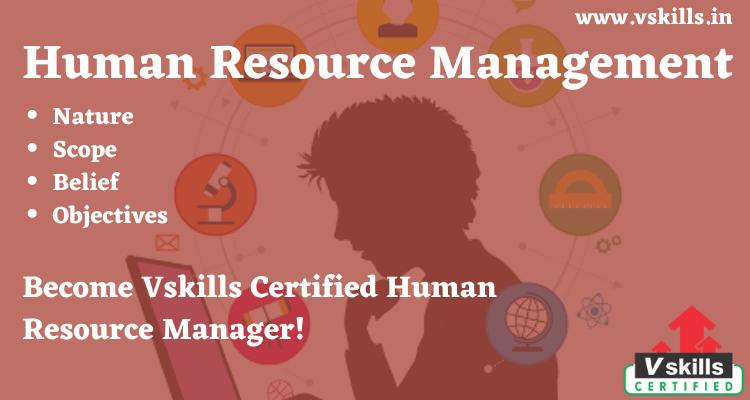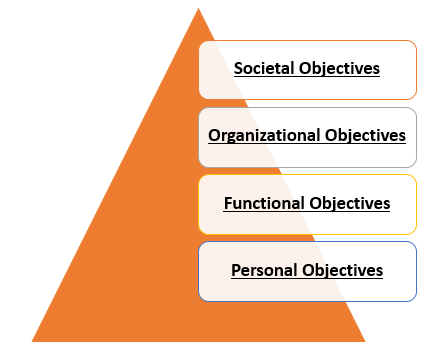Nature, scope, belief, and objectives of Human Resource Management
Nature of Human Resource Management
A hard approach to human resource management is a pragmatic perspective to human resource management which looks upon people as ‘resource’ and measures the tangible benefits accruing from their deployment.
The emphasis on:
- To drive for economy and efficiency
- Adoption of a strategic approach that is in line with business strategy
- Obtaining value-adding services from people through targeted human resource development practices
The ‘soft’ model of human resource management traces its origin to the human relations school of administrative thought and emphasizes development of healthy organizational culture by use of effective communication, motivation and leadership as primary sources of maximizing performance. It looks upon employees as ‘co-contributors’.
Scope of Human Resource Management
Scope refers to the work that should be completed to deliver a product, service, or result with the specified features and functions.
The scope of HRM can be encapsulated in three aspects:
- Personnel aspect: It focuses on manpower planning, recruitment, selection, placement, transfer, promotion, training and development, lay off and retrenchment, remuneration, incentives and productivity
- Welfare aspect: It emphasizes on working conditions and amenities like canteens, rest rooms etc.
- Industrial Relations aspect : It is elated to the legal and compliance part which covers union management relations, grievance redress, disciplinary procedures and settlement of disputes, etc.
HR function may be categorized into the following sub-sections:
- Employee Hiring
- Employee and Executive Remuneration
- Employee Motivation
- Employee Maintenance
- Industrial Relations
- Prospects of Human Resource Management
Human Resource Management: Beliefs
A belief is mental acceptance of and conviction in the truth, actuality, or validity of something. HRM emphasizes on the belief that the interests of management and employees are on same plane also, called as the ‘unitary’ approach’.
HRM beliefs can be listed as below:
- Human resource is the most important asset which can develop and increase.
- In a workplace, all employees are equal but have different jobs and because of which they add value every day.
- Employees are my most important assets.
- True diversity is welcome at workplace.
- Company operations are transparent to employees.
- A healthy environment of openness, enthusiasm, trust and collaboration is essential for productive human resource.
- HRM can be planned and monitored for achieving the objectives of the organization.
- A feeling of belonging by the organization makes employees feel committed to their work.
- When basic and higher level needs of employees are fulfilled, they feel highly motivated.
- Every senior should ensure the development and utilization of the capabilities of it’s juniors.
Objectives of Human Resource Management
The primary objective of human resource management is to ensure the availability of a productive workforce to an organization. Hence, objectives of HRM are classified into the following four categories:
HRM Objectives and their supporting functions are listed below:
Societal Objectives
1. Legal compliance
2. Benefits
3. Union management relations
Organizational Objectives
1. Human resource planning
2. Employee relations
3. Selection
4. Training and development
5. Appraisal
6. Placement
7. Assessment
Functional Objectives
1. Appraisal
2. Placement
3. Assessment
Personal Objectives
1. Training and development
2. Appraisal
3. Placement
4. Compensation
5. Assessment
A set of emerging objectives comprises of:
- Research and development for constant updating in view of changing legal, political, and social environment.
- Realise people’s strengths, turn them into productive assets and benefit customers, stockholders and employees.
- Motivating the employees to make them exert their maximum efforts.
- Helping employees grow to their fullest potential by improving the quality of work life (QWL)
Practice Questions
Q1. Which of the following is not an objective of HRM?
a) To create a motivated and committed workforce
b) To increase productivity and efficiency
c) To minimize employee turnover
d) To maximize profits for the organization
Correct Answer: d) To maximize profits for the organization
Q2. Which of the following is an objective of HRM related to employee development?
a) To recruit the best talent available
b) To provide competitive salaries and benefits
c) To provide training and development opportunities
d) To maintain a safe and healthy work environment
Answer: c) To provide training and development opportunities
Q3. Which of the following is an objective of HRM related to employee relations?
a) To ensure compliance with labor laws and regulations
b) To maintain positive relationships with labor unions
c) To promote employee involvement and participation
d) All of the above
Correct Answer: d) All of the above
Q4. Which of the following is an objective of HRM related to strategic planning?
a) To align HR practices with organizational goals
b) To create a diverse and inclusive workplace
c) To provide a fair and equitable work environment
d) To ensure employee safety and health
Correct Answer: a) To align HR practices with organizational goals
Q5. Which of the following is an objective of HRM related to compensation and benefits?
a) To attract and retain talented employees
b) To provide a safe and healthy work environment
c) To ensure compliance with labor laws and regulations
d) To promote employee involvement and participation
Correct Answer: a) To attract and retain talented employees




